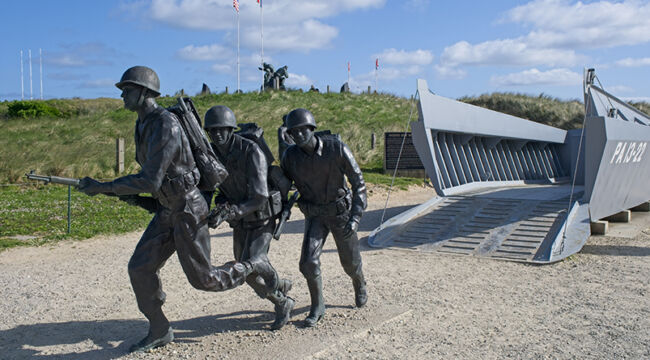“L”- Day
I suspect you thought that June 6, 1944, was D-Day, when U.S.-British-Canadian and other Allies invaded Normandy, France, eighty years ago today. Yes, I know that the event is called D-Day, but for reasons I’ll explain in a moment, let’s go with the letter “L.” Bear with me…
Who Put the “D” in D-Day?
D-Day is a confusing label. There’s no correct explanation for the letter “D,” not now nor back on June 6, 1944. In fact, in 1964, not quite twenty years after the end of the Second World War, an interviewer asked retired General and former U.S. President Dwight Eisenhower what the D meant. Ike tilted his head, thought for a moment, and wasn’t exactly sure, but it might represent “departure day” when troops kicked off toward the beaches.

General Eisenhower and airborne troops, June 5, 1944. U.S. National Archives.
This brings me back to calling the event “L-Day” because the landings were very much about logistics — mostly about logistics, truthfully. Or, as Admiral Ernest King (no relation), Chief of Naval Operations for most of World War II, once quipped, “I don’t know what the hell this ‘logistics’ is, that [General George] Marshall is always talking about, but I want some of it.”
As an editorial point of privilege, I’ll mention my long-departed father, Homer King, who served as an Army combat pilot and flew ground attack missions during the June 6 landings. At one point, he piloted his heavily damaged P-47 fighter-bomber back to England, shot full of holes and leaking fuel.
He landed and traded his bird in for another one without all the unintended air conditioning. Then he flew back to France. Much later, and somewhat to his surprise, he was called into the colonel’s office to receive a Distinguished Flying Cross.

“For extraordinary achievement while participating in aerial flight.” U.S. Department of Defense.
Depending on your age and origins, perhaps you, too, had a father or grandfather, uncle, etc. (and yes, more than a few women in uniform) who participated in the fight in Europe, 1941 – 45. Perhaps your relatives served in the Pacific Theater or some other front across the globe. Or they remained home in the U.S., possibly working at a defense plant. Or maybe it’s none of the above, and don’t worry ‘cuz it’s all good. June 6 is your day, too.
Sadly, we live in an era when history is poorly taught in most schools and generally unappreciated across our culture. And if the cultural elite shuns any field of history, it’s military history. Just try to find a decent university program in military history at any U.S., Canadian, or British university (hint: good luck; you’ll be laughed out of the faculty lounge at most schools if you say you want to work in military history).
Meanwhile, if you want to be underwhelmed, walk through a college campus and ask 19- and 20-year-olds about World War II. To the extent that large numbers of people know much at all about June 6 and D-Day (or L-Day, as I’ll expand in a moment), it’s from movies like Saving Private Ryan (1998) or The Longest Day (1962); or perhaps the television series Band of Brothers (2001).
Okay, pilgrims… I’ll take some knowledge of the war over none at all. However, the problem with what you see in movies is that there are a lot of action scenes with soldiers hitting the beach or parachuting from airplanes. They land on the sand, rifle in hand, taking fire from enemy machine guns and artillery. They run up hills, blast away, toss hand grenades, capture pillboxes, and mow down the other side’s soldiers.
As it all unfolds, one sees the Hollywood human side, with soldierly bonding, everyone looking out for their buddies, people being wounded and killed, and survivors living to fight another day.
Which is to say, learning “history” from watching movies is quite misleading. Because whatever they show on the screen, everything about fighting a war comes back to logistics.
Gimme the Fuel, Ammunition and Supplies
Consider this: How much gear do you think a typical soldier carries when he jumps out of an airplane or when the landing craft’s ramp drops down? Forty pounds? 50? 75?
How much ammunition can anyone carry? How many rounds? How many hand grenades? What about troops who haul machine guns or mortars? Crew-served weapons weigh more than you think, as do the rounds they fire.
What about medical supplies? Or radios and batteries? Fresh water? And maybe some food? Plus, say, a small shovel, and maybe a rain poncho. And… you get the idea, right?
Here’s the point. When Tom Hanks and his troops hit the beach in Saving Private Ryan and then humped through minefields and across the dunes, dodging bullets and shrapnel, every one of them had a combat-service life of about an hour, likely less. Because in a very short time span, they would have fired all their ammunition, tossed the grenades, used up the medical supplies, and (as the movie showed) the radio would be shot through.
And then what? Well… If it’s you in the dirt, hunkering undercover, you better have some of that “logistics” thing backing you up.
That is, after the first boats hit the beach and land troops, the next wave had better be right behind, hauling more troops to replace casualties and a lot of useful supplies, all staged for fast extraction and movement across open fields of fire. More rifle rounds, grenades, mortar shells, ammo belts for machine guns, medical supplies, and people to treat and evacuate the wounded.
Then comes engineering equipment like mine clearance devices and armored bulldozers to dig out firing positions. Plus, mobile field artillery and ammunition, along with gun crews and repair kits for when things break, because they always break.
And then, in other landing craft, not far behind that second or third wave, you require armored equipment like tanks and personnel carriers, hauling fuel (lots!), ammunition, communication gear, and much more.
Of course, to accomplish the overall mission, the U.S. had to build entire fleets — over ten thousand — of cargo ships and landing craft, along with enough equipment to stage and wage a land war across northern Europe. This illustrates how logistics reflects a nation’s industrial power; stated another way, military power is the first derivative of a nation’s energy base and industrial system.
If you want ships, you need steel and machinery. But if you allocate steel and machinery to build ships, then the metal and equipment will not go into tanks or trucks. Plus, you need everything else that goes into ships, ranging from propellers to anchor chains, plus trained crews that take time to recruit and assemble.
The immediate takeaway is to recall and honor the bravery of soldiers and sailors past and the brilliance of planners who put Operation Overlord together. That, and understanding that nothing big, complex, and important happens absent immense levels of thought and attention to detail; it could not happen back then and does not happen today. Which is to say, bone up on your logistics.



Comments: